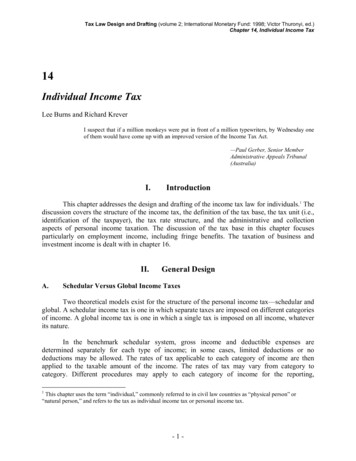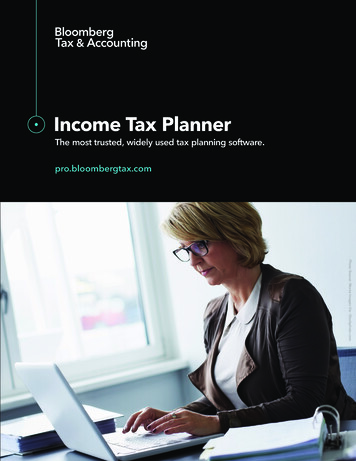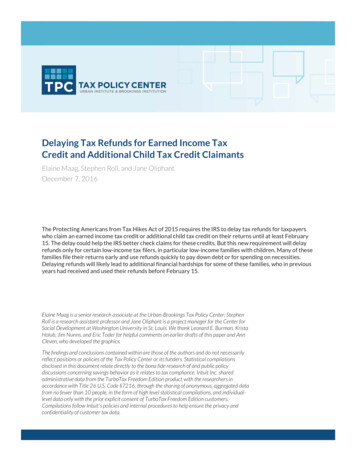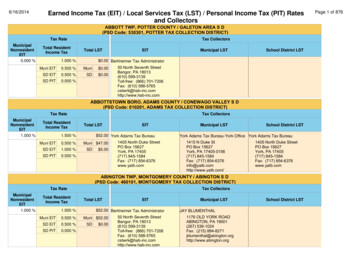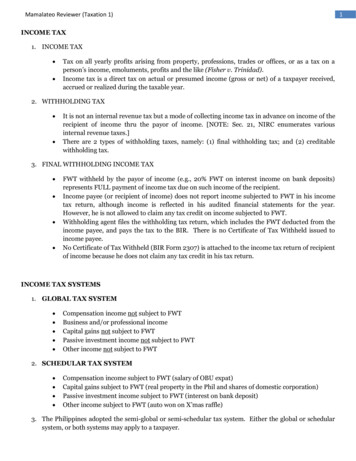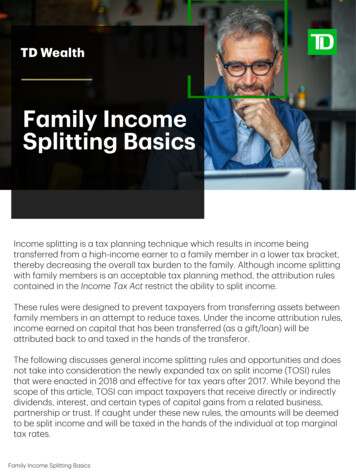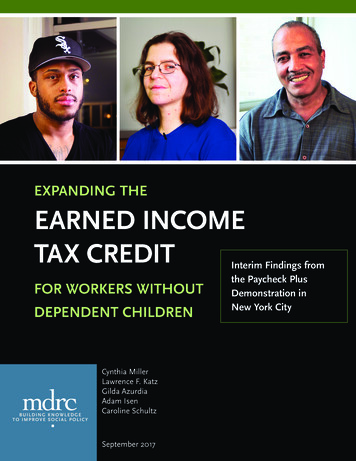
Transcription
EXPANDING THEEARNED INCOMETAX CREDITFOR WORKERS WITHOUTDEPENDENT CHILDRENCynthia MillerLawrence F. KatzGilda AzurdiaAdam IsenCaroline SchultzSeptember 2017Interim Findings fromthe Paycheck PlusDemonstration inNew York City
Expanding the Earned Income Tax Credit forWorkers Without Dependent ChildrenInterim Findings from the Paycheck Plus Demonstrationin New York CityCynthia Miller(MDRC)Lawrence F. Katz(Harvard University)Gilda Azurdia(MDRC)Adam Isen(U.S. Department of the Treasury)Caroline Schultz(MDRC)September 2017
Funding for the demonstration in New York is provided by the New York City Mayor’s Office forEconomic Opportunity, the Robin Hood Foundation, the Laura and John Arnold Foundation, theEdna McConnell Clark Foundation, and the U.S. Department of Health and Human Servicesthrough a Section 1115 waiver coordinated by the New York State Office of Temporary andDisability Assistance.Funding for the demonstration in Atlanta is provided by the Annie E. Casey Foundation, the W.K.Kellogg Foundation, the Kresge Foundation, the Ford Foundation, the U.S. Department of Healthand Human Services, the U.S. Department of Labor, and the Lifepath Project.Dissemination of MDRC publications is supported by the following funders that help financeMDRC’s public policy outreach and expanding efforts to communicate the results and implications of our work to policymakers, practitioners, and others: The Annie E. Casey Foundation,Charles and Lynn Schusterman Family Foundation, The Edna McConnell Clark Foundation, FordFoundation, The George Gund Foundation, Daniel and Corinne Goldman, The Harry and JeanetteWeinberg Foundation, Inc., The JPB Foundation, The Joyce Foundation, The Kresge Foundation,Laura and John Arnold Foundation, Sandler Foundation, and The Starr Foundation.In addition, earnings from the MDRC Endowment help sustain our dissemination efforts. Contributors to the MDRC Endowment include Alcoa Foundation, The Ambrose Monell Foundation,Anheuser-Busch Foundation, Bristol-Myers Squibb Foundation, Charles Stewart Mott Foundation, Ford Foundation, The George Gund Foundation, The Grable Foundation, The Lizabeth andFrank Newman Charitable Foundation, The New York Times Company Foundation, Jan Nicholson, Paul H. O’Neill Charitable Foundation, John S. Reed, Sandler Foundation, and The StupskiFamily Fund, as well as other individual contributors.The findings and conclusions in this report do not necessarily represent the official positions orpolicies of the funders or of the U.S. Department of the Treasury.For information about MDRC and copies of our publications, see our website: www.mdrc.org.Copyright 2017 by MDRC . All rights reserved.
OverviewIn recent decades, wage inequality in the United States has increased and real wages for less-skilledworkers have declined. As a result, many American workers are unable to adequately support theirfamilies through work, even working full time. The Earned Income Tax Credit (EITC) has helped tocounter this trend and has become one of the nation’s most effective antipoverty policies. But mostof its benefits have gone to workers with children. The maximum credit available to workers withoutdependent children is just over 500, and workers lose eligibility entirely once their annual earningsreach 15,000.There has been bipartisan support for expanding the EITC for this group of workers. Paycheck Plusis a test of that idea. The program, which provides a bonus of up to 2,000 at tax time, is beingevaluated using a randomized controlled trial in two major American cities: New York City andAtlanta, Georgia. This report presents interim findings from the test of Paycheck Plus in New YorkCity. Between September 2013 and February 2014, the project in New York recruited just over6,000 low-income, single adults without dependent children to take part in the study. Half of themwere selected at random to be offered a Paycheck Plus bonus for three years, starting with the 2015tax season.FindingsThe program sought to mirror the process by which filers apply for the federal EITC, even thoughthe bonus was not administered by the Internal Revenue Service. Participants needed to apply foreach bonus, and receipt of it was not automatic with tax filing. About 64 percent of individuals in the program group who had earnings in the eligible rangereceived bonuses in the first year (2015), and 57 percent received bonuses in the second year(2016). Among those who received bonuses, the average amount received was 1,400. Paycheck Plus increased after-bonus income (earnings plus bonuses) in both years, and increased employment in 2015. Paycheck Plus increased tax filing in both tax filing seasons. Paycheck Plus increased the payment of child support in 2015. Paycheck Plus increased employment in 2015 for most types of participants, although its effectswere larger among women than among men.These findings are consistent with research on the federal EITC showing that an expanded credit canincrease after-transfer income and encourage employment without creating work disincentives.Later reports will examine effects after three years on income, work, and other measures of wellbeing, in both New York City and Atlanta.iii
ContentsOverviewList of ExhibitsPrefaceAcknowledgmentsExecutive SummaryiiiviiixxiES-1Chapters1Introduction12The Earned Income Tax Credit568Proportion of Eligible Families ReachedEffects3The Paycheck Plus Demonstration11111516181821Recruitment and EnrollmentData SourcesResearch Questions and Expected EffectsParticipants’ CharacteristicsThe New York City ContextPaycheck Plus in Atlanta4Implementation and Bonus Receipt RatesApplying for the BonusBonus ProcessingBonus Receipt RatesBonus Receipt Rates Among Subgroups5Effects on Income, Work, Earnings, and Other OutcomesEffects on Employment, Earnings, and IncomeEffects on Filing TaxesEffects for SubgroupsEffects on Child Support A Supplementary Documents53B Testing the Effects of a Referral to Employment Services59v
C Baseline Equivalence of Research Groups63References67Earlier MDRC Publications on Paycheck Plus71vi
List of ExhibitsTableES.1Effects on Work, Earnings, and IncomeES-83.1Sample Characteristics193.2Baseline Characteristics of Men and Women204.1Paycheck Plus Bonus Receipt in 2015 and 2016294.2Paycheck Plus Bonus Eligibility and Receipt Among Selected Subgroups in2015 and 2016354.3Bonus Receipt in 2015 and 2016, by Earnings Level375.1Effects on Employment, Earnings, and Income405.2Effects on Employment and Earnings Covered by Unemployment Insurance425.3Effects of Employment-Referral Services Among Program Group MembersWho Earned Less Than 10,000 in the Year Before They Entered the Study445.4Effects on Tax Filing455.5Effects for Subgroups, Year 1 (Tax Year 2014)475.6Effects for Subgroups, Year 2 (Tax Year 2015)485.7Effects on Child Support Payments and Debt Among Noncustodial Parents50C.1Baseline Characteristics, by Research Group65FigureES.1Paycheck Plus Versus the Federal EITCES-3ES.2Paycheck Plus Bonus ReceiptES-62.1EITC for Single Adults with Different Numbers of Children, 20163.1Paycheck Plus Versus the Federal EITC123.2Program Timeline and Follow-Up Period for This Interim Report144.1Paycheck Plus Outreach Postcard254.2Distribution of Program Group Members, by Earnings and Eligibility Status314.3Bonus Receipt Rates Among Eligible Individuals, by Expected Bonus Amount33vii7
A.1Paycheck Plus Take-Home Sheet55A.2Employment-Referral Service Supplementary Insert56The Power of Prompts: Using Insights from Behavioral Science to EncouragePeople to Participate24Box4.1viii
PrefaceThe Earned Income Tax Credit (EITC) has been one of the nation’s most effective antipovertypolicies. It has helped to counteract decades of stagnating or even falling wages for the bottompart of the wage distribution, increasing employment among single mothers and raising millionsof families and children out of poverty.But it could do more. One important and sizable group has been left out of the EITC’sreach: low-income workers who do not have dependent children. This group includes youngmen and women just starting out, older workers with adult children, and parents who do nothave custody of their children. All have faced the same falling wages over the past decades asworkers with children, and the same tough labor market of more recent years, and all couldbenefit from an expanded tax credit. Yet there has been little or no public-policy response.An expanded credit for this group is not a new idea. Representatives from both politicalparties have called for a more generous EITC for childless workers. Part of the bipartisan appealof the EITC is that it reduces poverty while also encouraging work. What is new aboutPaycheck Plus is that it tests this idea in two large cities. Testing a tax refund as a demonstration, outside of the Internal Revenue Service, brings with it a set of challenges. Eligible workersdid not automatically get bonuses if they filed taxes, for example, as they would if an expandedcredit were part of the tax code. Instead they had to go through additional steps. Recipients andeven tax preparers did not necessarily understand even the EITC itself, and the project had tomake sure that participating workers knew and trusted the new program.The early results are encouraging. Most eligible workers received bonuses. PaycheckPlus increased workers’ incomes and also led a modest increase in employment rates. It also ledto an increase in child support payments among parents who owed them. The findings areconsistent with a large amount of other research showing that work-based earnings supplementssuch as the EITC boost employment and earnings while increasing work effort.The fact that single people working in low-wage jobs are treated differently from thosewith children raises questions of equity. The findings presented here show that an expanded taxcredit can encourage work and increase incomes, just as the EITC has already done for singlemothers. Although such a credit would not fully make up for decades of falling wages, it wouldbe a start.Gordon L. BerlinPresident, MDRCix
AcknowledgmentsThis report reflects the generous contributions and support of many people. We are especiallygrateful to the individuals participating in the Paycheck Plus evaluation, who have allowed us tolearn from their experiences. We also appreciate the assistance of the many staff members at theVolunteer Income Tax Assistance (VITA) sites who helped operate the program.The project would not have been possible without the work and dedication of severalindividuals and organizations, including Linda Gibbs, former New York City deputy mayor forHealth and Human Services; Kristin Morse, former executive director of the New York CityMayor’s Office for Economic Opportunity (NYC Opportunity); and several staff members atNew York City’s Human Resources Administration. We thank Carson Hicks and Jean-MarieCallan at NYC Opportunity for continued support and guidance throughout the project. We alsothank Michele Ahern and her colleagues at the New York City Office of Child Support Enforcement for assistance in implementing the program and for providing child support data.German Tejeda, Arlene Sabdull, and Andy Nieto at Food Bank for New York City wereinstrumental in getting the program up and running. We also thank Dale Grant and PatriciaBrooks of Grant Associates for assistance with designing and implementing the employmentreferral services.The authors thank Gordon Berlin, Dan Bloom, Rob Ivry, John Hutchins, and JamesRiccio from MDRC, and Carson Hicks and Jean-Marie Callan from NYC Opportunity for theirhelpful comments on the report. The authors also received comments from the Paycheck PlusPolicy Advisory Group: Chuck Marr, Lauren Pescatore, and Eugene Steuerle.At MDRC, Alexandra Bernardi coordinated Paycheck Plus program operations in NewYork City and contributed valuable insights for this report. Kali Aloisi and Paul Veldmanprocessed the quantitative data and Kali Aloisi also coordinated the production of the report.Leslyn Hall helped design the survey instrument and monitored its administration. JoshuaMalbin edited the report and Ann Kottner prepared it for publication.The Authorsxi
Executive SummaryIn recent decades, wage inequality in the United States has increased and real wages for lessskilled workers have declined. Wages have increased for workers with college degrees by 19percent since the early 1970s, but have fallen by 17 percent for workers without high schooldiplomas. 1 As a result, many American workers are unable to adequately support their familiessolely through work, even working full time.The Earned Income Tax Credit (EITC) has helped to counter rising earnings inequalityand stagnating real wages by increasing the incomes of low-income workers. A working, singlemother with two children, for example, can get a federal tax refund of up to 5,600 at tax-filingtime from the EITC. The credit has been expanded substantially since the 1980s and is now oneof America’s most effective antipoverty policies. 2 However, the EITC does little to help lowwage workers who do not have dependent children, a group that has faced the same tough labormarket as those with children. The maximum credit a worker without dependent children canreceive is 506, 3 and that worker loses eligibility once his or her earnings reach 15,000. Putdifferently, an individual working full time at 9 per hour would earn too much to qualify forany credit. This disparity in the treatment of these two types of workers in low-wage jobs raisesquestions of equity.Policymakers on both sides of the aisle have recognized the value of the EITC as a policy that both reduces poverty and encourages work, and they have also promoted the idea ofexpanding it for adults without dependent children. Paycheck Plus is a test of that idea. Theprogram, which provides up to 2,000 at tax time, is being evaluated using a randomizedcontrolled trial in two major American cities: New York City and Atlanta, Georgia. PaycheckPlus in New York City is funded by the New York City Mayor’s Office for Economic Opportunity (NYC Opportunity), the Robin Hood Foundation, the Laura and John Arnold Foundation,the Edna McConnell Clark Foundation, and the U.S. Department of Health and Human Services. 4 The test in Atlanta is being funded by the Ford Foundation, the Annie E. Casey Founda1Economic Policy Institute, “Wages by Education” (website: www.epi.org/data/#?subject wageeducation, 2017).2Center on Budget and Policy Priorities, “Policy Basics: The Earned Income Tax Credit” basics-the-earned-income-tax-credit, 2016); Austin Nichols andJesse Rothstein, “The Earned Income Tax Credit,” pages 137-218 in Robert A. Moffitt (ed.), The Economics ofMeans-Tested Transfer Programs in the United States Volume 1 (Chicago: University of Chicago Press, 2016).3In 2017, for tax year 2016.4The U.S. Department of Health and Human Services’ Office of Child Support Enforcement, with thesupport of the New York State Office of Temporary and Disability Assistance, is providing funding to thedemonstration in New York through a Section 1115 waiver.ES-1
tion, the Kellogg Foundation, the U.S. Department of Health and Human Services, the U.S.Department of Labor, and the Lifepath Project. MDRC worked with NYC Opportunity todesign the demonstration and partnered with the New York City Human Resources Administration and Food Bank for New York City to implement the program. MDRC is also evaluating itseffects.This report presents interim findings from the test of Paycheck Plus in New York City,presenting the proportion of participants who actually received the expanded credit in the firsttwo years, and the credit’s effects over that time on income, work, earnings, tax filing, and childsupport payments. The findings are consistent with research on the federal EITC showing thatan expanded credit can increase after-transfer incomes and encourage employment withoutcreating work disincentives. Later reports will examine effects after three years on income,work, and other measures of well-being, in both New York City and Atlanta.Paycheck PlusPaycheck Plus tests the effects of a much more generous EITC for childless adults. Figure ES.1compares Paycheck Plus with the current EITC for workers without dependent children. Underthe current EITC, a worker loses eligibility for benefits once his or her earnings reach about 15,000 and the maximum benefit that he or she can receive is 506. Paycheck Plus increasesthe maximum amount to 2,000 and expands eligibility so that more low-wage workers qualifyfor the maximum benefit. An individual can continue receiving some benefits until his or herearnings reach just under 30,000. The Paycheck Plus bonus “tops up” the federal EITC,bringing a worker’s total credit up to a maximum of 2,000. Finally, as is the case with thefederal EITC, some or all of the bonus may be intercepted to pay down child support debt owedby a noncustodial parent (a parent who does not have custody of at least one of his or herchildren).MDRC partnered with Food Bank for New York City (FBNYC) to run the project inNew York. FBNYC, which runs the largest network of Volunteer Income Tax Assistance(VITA) sites in the city, directed its recruitment effort to organizations in its network andthroughout the city that served populations who qualified for Paycheck Plus. Additionaloutreach was conducted through the New York City Human Resources Administration’s cashassistance program, Supplemental Nutrition Assistance Program, and child support program.Between September 2013 and February 2014, the project recruited 6,000 single adults withoutdependent children to take part in the study, all of whom had earned less than 30,000 in theprevious year.Once individuals agreed to participate, half of them were assigned at random to a groupoffered Paycheck Plus and half were assigned to a group not offered the program but still ableES-2
Figure ES.1Paycheck Plus Versus the Federal EITC 2,000 2,000Paycheck PlusCredit amount 1,500Phase-in:30%Phase-out:17% 1,000 506 500Federal EITC 2016 0 0 10,000 14,880 20,000 29,900Annual earningsSOURCES: Urban Institute and Brookings Institution Tax Policy Center (2016); Paycheck Plus programdocuments.NOTES: Federal EITC illustrates the credit schedule for a single adult with no qualifying children.The phase-in and phase-out rates for the federal EITC shown are 7.65%.to claim existing tax credits. Individuals assigned to the Paycheck Plus group were given a briefexplanation of the bonus on a take-home sheet that illustrated the bonus amounts for variousearnings levels. The bonus was available to the program group for three years, payable at taxtime in 2015, 2016, and 2017, based on earnings in the previous year.The program sought to mirror the process by which filers apply for the federal EITC,even though the bonus was not actually administered by the Internal Revenue Service (IRS).One important difference was that participants would need to apply for each bonus; they did notES-3
receive it automatically once they filed taxes. To apply for the bonus, participants first had tofile their taxes (at FBNYC VITA sites, by using other free or paid tax preparers, or by preparingtheir own taxes). Workers who filed their own taxes or used tax preparers other than VITA sitescould bring in or mail in copies of the tax documents that they filed. Once bonus amounts weredetermined, MDRC worked directly with FBNYC and its payment vendor to request, issue, andmonitor the deposit of each bonus payment to a bank account or debit card.Program staff members faced several challenges in testing the effects of an expandedEITC. First, for there to be a fair test of the program, study participants had to understand andremember the bonus. As is the case with the existing EITC, the structure of the bonus is sometimes challenging to understand. Second, program enrollment took place a full year beforeparticipants could receive their first bonuses, to allow time for them to adjust their work andearnings in response. The lag meant that many study participants could have forgotten about thebonus and could have failed to claim it at tax time. Third, claiming the bonus required extrasteps from participants beyond just filing taxes. To address these challenges, staff membersconducted substantial marketing and outreach to individuals in the program group, starting inthe spring of 2014 and continuing in the months leading up to each tax season during which thebonus would be paid.The study will measure the program’s effects on a range of outcomes, the most immediate being income, poverty, and work. The expectation is that the bonus should increase afterbonus incomes among those who receive it and, by increasing the payoff to working, couldincrease employment rates. Economic theory suggests that the program might reduce workeffort among higher earners, since the credit is taxed away as earnings increase. The study willgauge whether that reduction takes place.Finally, increases in after-bonus income and work could have a range of other effectson participants, including reductions in material hardship, improvements in health and subjective well-being, increased child support payments, and reduced involvement with the criminaljustice system. The data used for this report include records from the unemployment insurancesystem, child support payment records, and tax records provided by the IRS, including information from tax forms for all tax filers and W-2 and 1099 forms for all individuals whether ornot they filed taxes.The sample recruited for the study in New York reflects the diversity of low-wageworkers. About 59 percent of the sample members are men, 47 percent were age 35 or olderwhen they joined the study, 22 percent had not obtained a high school diploma or equivalent,and 18 percent had been incarcerated at some point in the past. In addition, 9 percent werenoncustodial parents. Although nearly all participants had worked at some point in the past,ES-4
about a third had no earnings in the year before they enrolled. Another 30 percent had worked inthe previous year but earned less than 7,000.Findings About 64 percent of program group members with earnings in the eligible range received bonuses in the first year, and 57 percent received bonuses in the second year. Among those who received bonuses, the average amount received was 1,400.Overall, about 46 percent of the full program group received bonuses in 2015 (see Figure ES.2). It was expected that some number of participants would not be eligible for bonuses,either because they had no earnings or because they had earnings above the 30,000 eligibilitycutoff. Low-income earners often have highly variable earnings and employment from year toyear. About 70 percent of the program group met the earnings requirement to receive the bonusin 2015 (based on earnings during 2014), and 64 percent of this eligible group received bonusesin 2015. This “take-up rate” is in line with take-up rates of the federal EITC for adults withoutdependent children, most recently estimated at 65 percent.5 Bonus receipt fell for the fullprogram group from 46 percent of all program group members in 2015 to 35 percent in 2016, inpart because fewer participants had earnings in the eligible range and in part because those whowere eligible claimed the bonus at lower rates.Some eligible individuals did not claim the bonus because they did not file taxes, particularly if they had very low earnings. However, even among those who filed taxes, not allapplied for the bonus. Recall that individuals were required to apply for the bonus each year. Ifthe federal EITC were made more generous for childless adults along the lines of PaycheckPlus, take-up would probably be higher, since tax filing would trigger the credit automatically. Lower proportions of eligible men than women received the bonus, particularly men who were noncustodial parents or former prisoners.In 2015, 74 percent of eligible women received bonuses compared with 58 percent of eligiblemen. Women were more likely to receive bonuses than men in part because they were morelikely to work, but largely because those with earnings in the eligible range were more likely tofile taxes, and were also more likely to apply for bonuses if they did file taxes.5Maggie R. Jones, “Changes in EITC Eligibility and Participation, 2005-2009,” Center for AdministrativeRecords Research and Applications Working Paper #2014-04 (Washington, DC: U.S. Census Bureau, Centerfor Administrative Records Research and Applications, 2014).ES-5
Figure ES.2Paycheck Plus Bonus Receipt46%Receipt among the full program group2015 (tax year 2014)35%2016 (tax year 2015)64%Receipt among those eligible57%76%Receipt among eligible tax filers69%SOURCES: IRS tax forms, W-2s, and 1099-MISCs; Paycheck Plus program data on bonus receipt.Relatively low percentages of former prisoners and noncustodial parents applied for andreceived bonuses, primarily because they were less likely to apply for bonuses when they hadearnings in the eligible range. They were less likely to apply even if they filed taxes. Forexample, 65 percent of eligible filers with previous incarcerations received bonuses, comparedwith 79 percent of eligible filers without previous incarcerations. Paycheck Plus increased after-bonus income in both of the first twoyears and increased employment in the second year.About 80 percent of the study sample reported earnings in 2014, with an average ofabout 10,000 (or 13,000 among those who had some earnings). The program did not have adetectable effect on employment rates — the fraction who had any earnings — in 2014 (seeES-6
Table ES.1). In 2015, however, the program led to a modest increase in employment of 2.5percentage points (over the control group rate of 73.8 percent). The size of the effect is withinthe range of what would be expected, given existing economic research on how responsiveindividuals’ work decisions are to incentives of this size. An analysis of the distribution ofearnings did not detect that the bonus reduced work effort among those who had higher earningswhen they enrolled in the study.The IRS data also can be used to create a rough measure of after-bonus income, definedas earnings minus taxes plus the bonus. On average, individuals in the program group had afterbonus incomes of about 10,049 in 2014 compared with 9,395 for the control group, a statistically significant increase of 654, or 7 percent. The increase in after-bonus income for thesubsequent year was 645, or 6 percent. Paycheck Plus increased tax filing and the use of free tax preparationservices.In both 2015 and 2016, program group members were more likely than control groupmembers to file taxes. For example, 68 percent of the control group filed taxes in 2015, compared with 73 percent of the program group.The program also led to a change in the methods used to prepare taxes. Single peopletypically do not file taxes at VITA sites, as evidenced by the low proportion of the control groupwho did so: only 20 percent filed taxes at VITA sites in 2015. As expected, given the ease withwhich participants could receive bonuses by filing there, the program led to a large increase inthe use of VITA sites in both years, effects of over 20 percentage points, with about half of theincrease coming from a reduction in the use of paid preparers. The increase in the use of VITAsites probably reduced tax-preparation costs for program group members, although it may havealso increased the time they had to wait for their taxes to be prepared. Paycheck Plus increased the payment of child support in the secondyear.When they entered the study, about 9 percent of participants were noncustodial parentswho had child support orders or who owed child support debt. Among these noncustodialparents, the program led to an increase in payments in 2015. About 80 percent of noncustodialparents in the program group made a payment during the year, compared with 71 percent ofthose in the control group. Similarly, the program group paid on average 191 per month inchild support, an increase of 54 over the control group.ES-7
Table ES.1Effects on Work, Earnings, and IncomeProgramGroupOutcomeControl Earnings ( )10,07910,047330.893After-bonus income ( )10,0499,395654 ***0.00176.373.82.5 **0.012Earnings ( )12,88512,6931920.560After-bonus income ( )12,10811,464645 **0.0152,9972,971Any earnings (%)2015Any earnings (%)Sample size (total 5,968)SOURCE: IRS tax forms, W-2s, and 1099-MISCs.NOTES: Earnings refers to wages plus self-employment income.After-bonus income refers to earnings plus credit amount minus taxes.A two-tailed t-test was applied to differences between the outcomes of the program and control groups.Statistical significance levels are indicated as: *** 1 percent; ** 5 percent; * 10 percent.Estimates were regression-adjusted using ordinary least squares, controlling for pre-random assignmentcharacteristics of sample members. Paycheck Plus increased employment for most types of participants, although its effects were larger among women than men.The overall positive effect on employment in 2015 is generally consistent among mosttypes of participants. However, the positive effect on employment in the second year is largeramong women than men. The program also increased women’s average earnings in 2014 byabout 7 percent, an effect that is different from the effect among men by a statistically significant amount. The larger effect among women is in line with previous research suggesting thatwomen’s employment is more responsive to economic incentives than men’s. The men inPaycheck Plus were less likely to file taxes
Paycheck Plus is a test of that idea. The program, which provides a bonus of up to 2,000 at tax time, is being evaluated using a randomized controlled trial in two major American cities: New York City and Atlanta, Georgia. This report presents interim findings from the test of Paycheck Plus in New York City.




